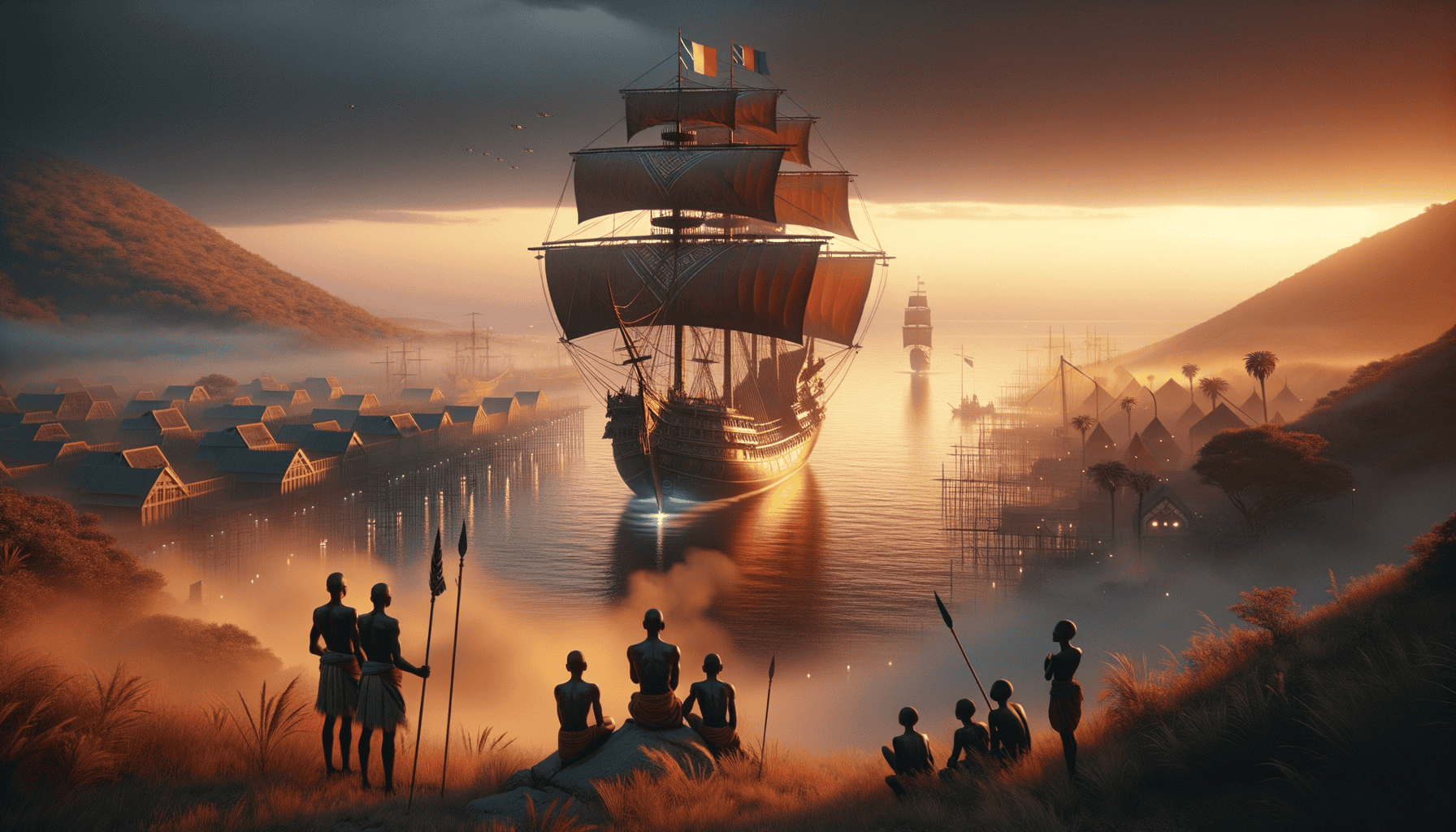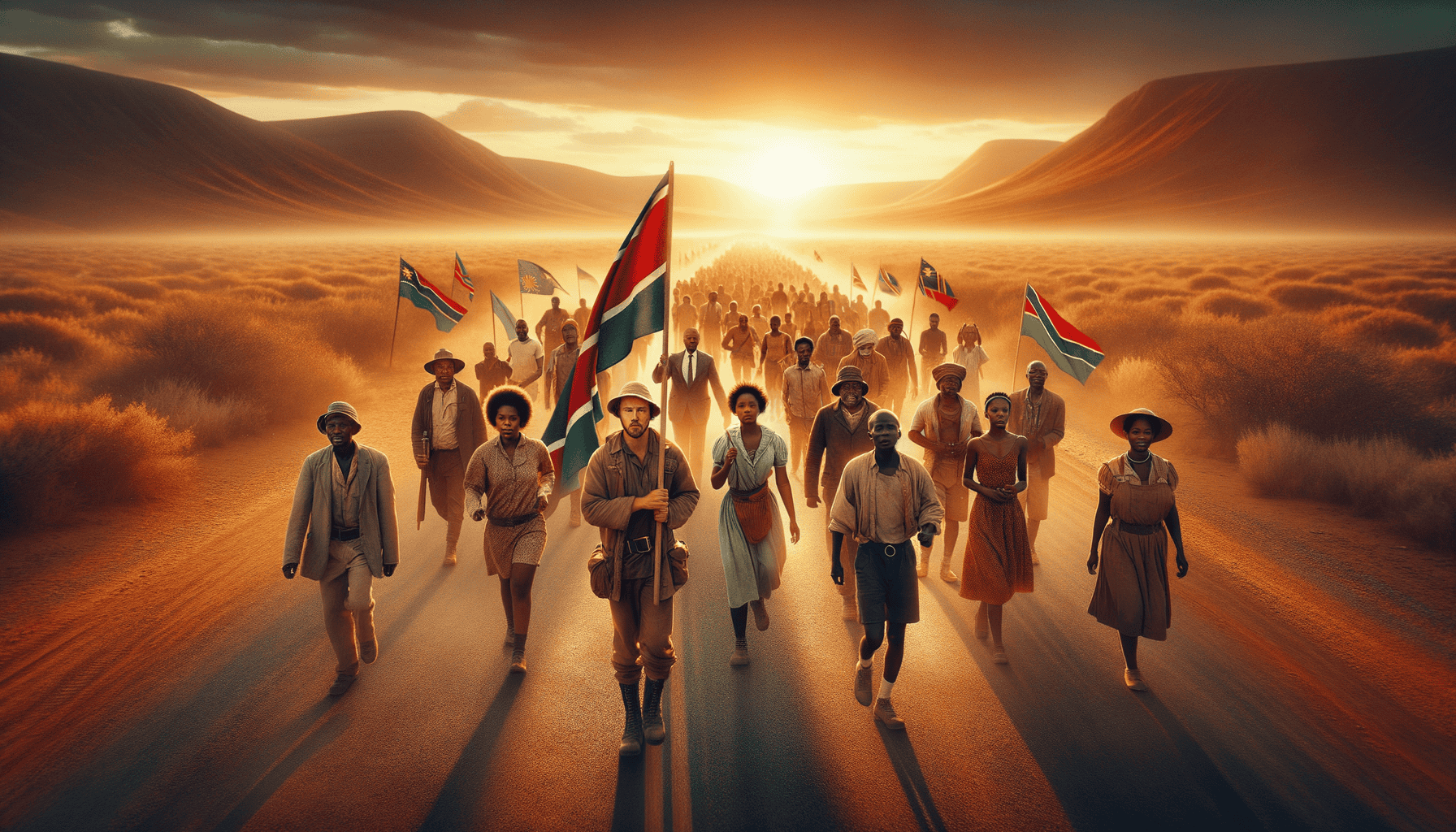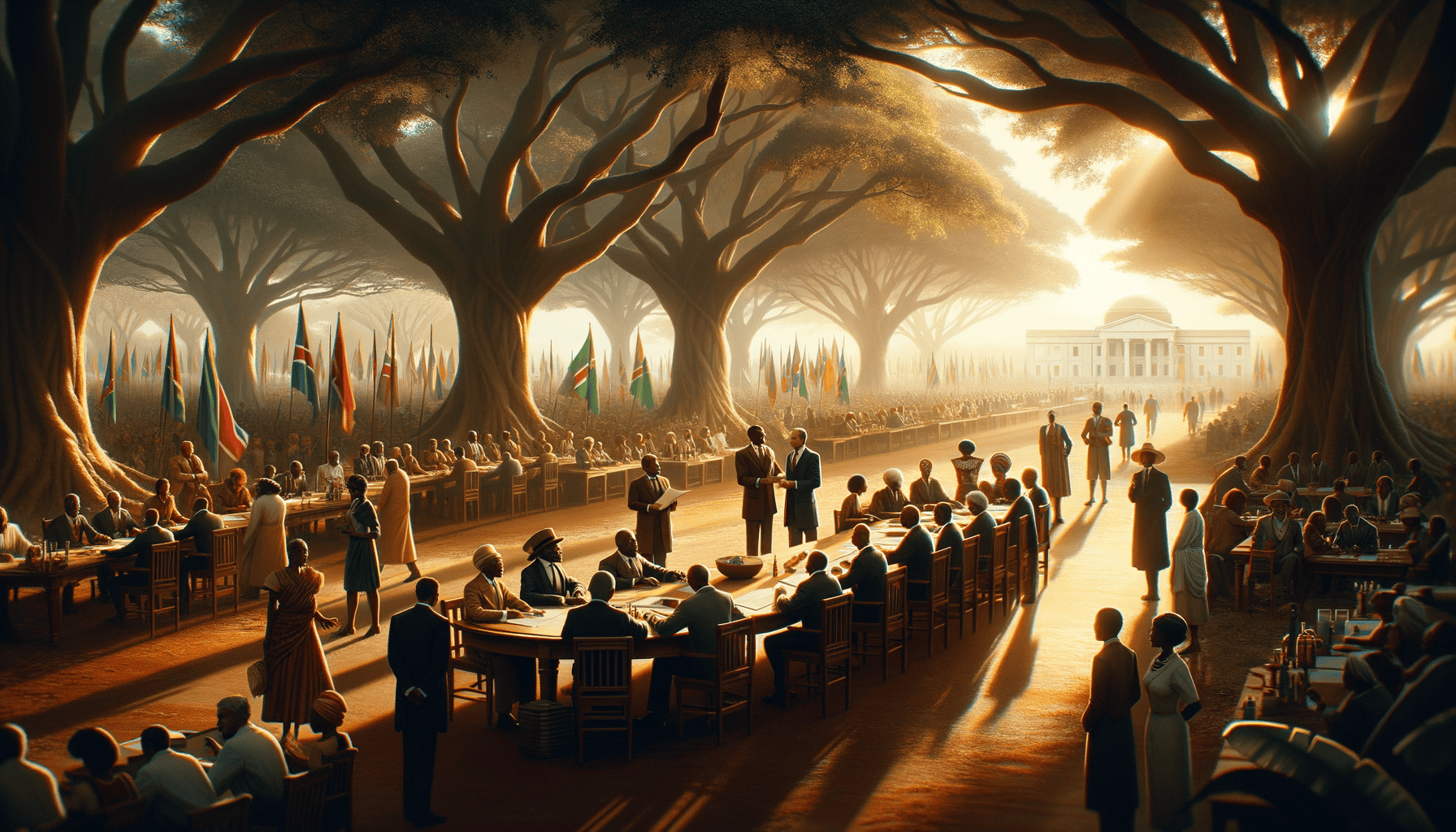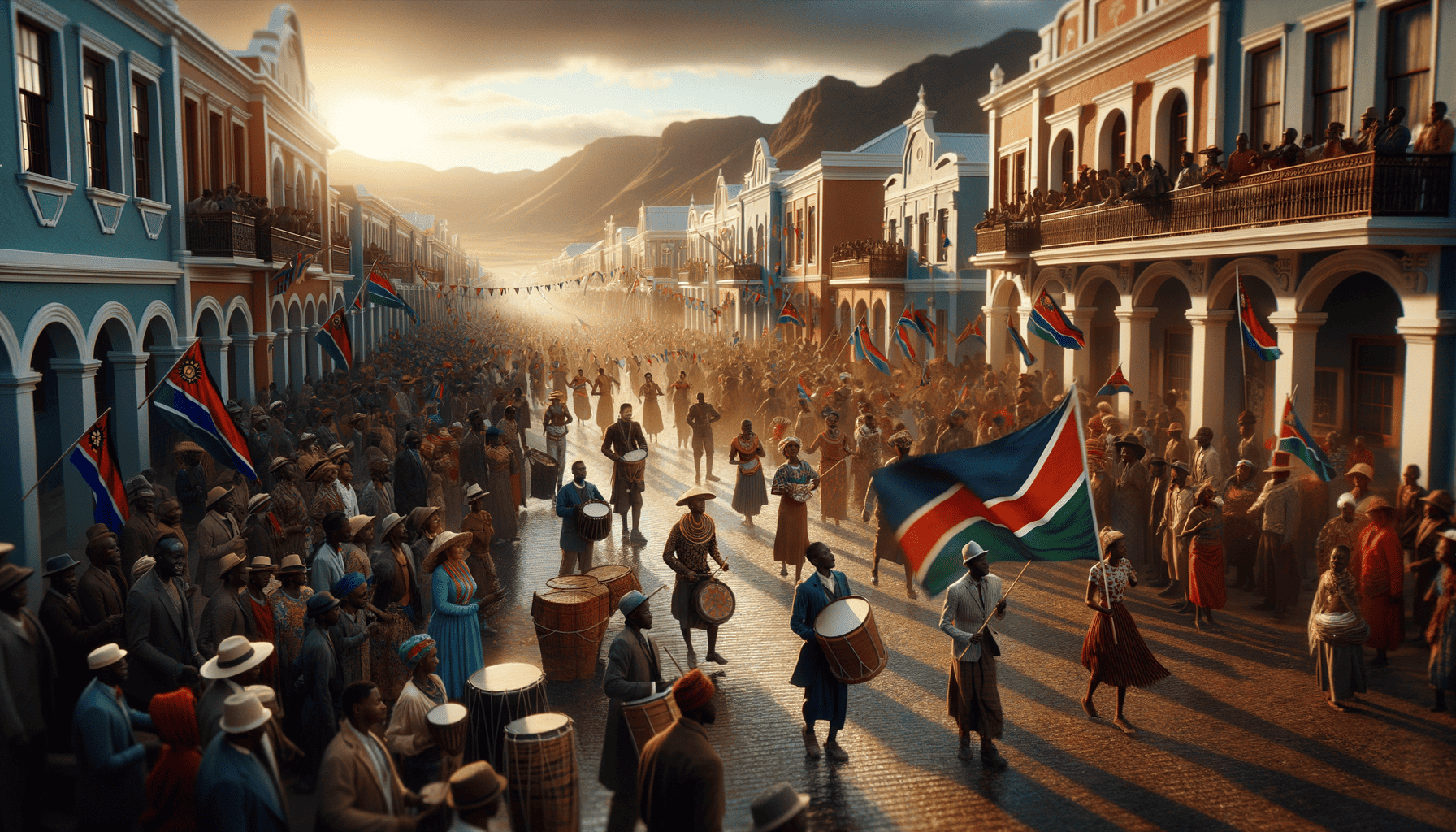Whispers of the Desert
The sun rose over the endless orange dunes of the Namib Desert, painting the sky in beautiful colors. This special place has been home to people for thousands and thousands of years.
Little Khoena sat with her grandmother near their small camp, watching the morning light dance across the sand. "Tell me about our home, Grandmother," she asked, her eyes bright with curiosity.
Grandmother smiled and pointed to the ancient rocks nearby. "See those pictures on the rocks? Our ancestors drew those many moons ago. They tell the story of our people, the San."
"The desert may look empty to some," Grandmother continued, "but it's full of life and secrets. Our people know how to find water in dry places and food where others see nothing."
Khoena watched a group of hunters return to camp. They carried special bows and arrows, just like in the rock paintings. The hunters used skills passed down from their parents, and their parents before them.
Life in the Ancient Desert
Every day, the San people worked together to survive in the desert. Some gathered sweet berries and crunchy nuts. Others tracked animals by looking at their footprints in the sand. They knew which plants could heal sick people and which ones were good to eat.
"Look at this, little one," Grandmother said, showing Khoena a special rock painting. It showed people dancing in a circle. "This is how our people have always celebrated. We dance to thank the earth for taking care of us."
The San people didn't need big houses or lots of things. They had something better – they knew how to live in harmony with the desert. They moved with the seasons and took only what they needed.
• How to find water in the desert
• Which plants were safe to eat
• How to make medicine from nature
• Ways to track animals
• Stories about their history
As the day grew warmer, Khoena helped her family gather food. She learned the names of different plants and animals. Each one had a special story. The clever jackals, the wise elephants, and the quick springbok all played important parts in San stories.
"Remember, Khoena," Grandmother said, "the desert is alive. It speaks to those who know how to listen. Our people have heard its whispers for many, many years."
That night, as the stars came out, the community gathered around the fire. The elders told stories about brave hunters and clever children. They sang songs that their grandparents had taught them.
Young Khoena felt proud to be part of this ancient story. She knew that just like the rock art that had lasted for thousands of years, the wisdom of her people would live on through stories told around the fire.
The moon rose high over the desert, and the night wind carried the sounds of singing across the dunes. In the flickering firelight, the ancient rock paintings seemed to dance, telling their timeless stories to anyone who would listen.
Strangers from Across the Sea
One sunny morning, young Khoena and her friend Tau were playing near the beach when they saw something strange in the distance. Big wooden ships with white sails appeared on the horizon.
“What are those?” Tau asked, pointing at the ships.
“I don’t know,” Khoena replied. “Let’s go tell the elders!”
The village elders gathered to watch as strange-looking people came ashore. They had pale skin and wore different clothes than the San people. These visitors were Portuguese sailors, though Khoena and her people didn’t know that yet.
New People, New Ways
More ships started coming to their shores. Some brought German people who wanted to build houses and towns. They were very different from Khoena’s people. They didn’t move with the seasons or live in harmony with the desert.
“Why do they build such big houses?” Khoena asked her grandmother one day.
“They come from a different world,” Grandmother explained. “They don’t know the desert’s ways like we do.”
• Big stone buildings
• New languages
• Different clothes
• Strange tools
• New animals like horses and cows
The German people called this land “German South West Africa.” They made new rules and started farms on the land where Khoena’s people used to hunt and gather food.
Standing Strong
Many local people didn’t like these changes. Chief Hendrik Witbooi, a brave leader, wrote letters telling the Germans to respect the local people’s ways. He said, “This land has been our home since the time of our great-great-grandparents.” ✊
Some communities fought back when the Germans tried to take their land. Others tried to keep their old ways of life while learning to live with the new neighbors.
Khoena watched as more changes came to her homeland. New towns grew bigger. More ships brought more people. But her grandmother still taught her the old ways – how to find water, which plants could heal, and the stories of their ancestors.
Learning to Share the Land
“The desert is big enough for everyone,” Grandmother would say. “But everyone must learn to respect it, and each other.”
Even with all the changes, the San people kept their stories alive. They still painted on rocks, danced under the stars, and taught their children about the desert’s secrets.
At night, Khoena would look at the new towns in the distance, their lights twinkling like stars. Then she would look at her family’s campfire, where the old stories were still told. She knew that somehow, the old and new ways would have to find a way to live together.
The moon rose over the changed landscape, shining on both the traditional camps and the new buildings. The desert wind still carried stories – old ones and new ones – across the ancient sands.
Dreams of Freedom
Time passed, and the people of Namibia grew tired of others ruling their land. Many brave men and women began to dream of freedom. They wanted to make their own choices about their future.
The Birth of Hope
One evening, young Tobias sat with his grandfather under a big acacia tree. The stars twinkled above them like tiny lanterns.
“Why are people meeting in secret, Grandfather?” Tobias asked.
His grandfather smiled gently. “They are planning for our freedom, little one. They want our people to rule our own land again.” ✨
Tobias watched as more and more people joined together. They sang songs about freedom and told stories about a better tomorrow. Some even wrote poems about their dreams for Namibia.
Standing Together
“Look at the ants, Tobias,” his grandmother said one day, pointing to a line of busy insects. “See how they work together? That’s how we must be – united and strong.”
People from different parts of Namibia began working together:
• Teachers taught children about their history
• Workers joined hands to demand better treatment
• Leaders spoke up for everyone’s rights
• Young people shared messages of hope
Many countries around the world started supporting Namibia’s wish to be free. They said, “Every people should rule their own land!”
Voices of Change
Sam Nujoma became an important leader. He spoke about freedom and helped unite people. Many listened to his words on secret radios.
“When will we be free?” Tobias asked his mother one night.
“Soon, my child,” she answered, hugging him close. “Change is coming like the rain clouds over the desert.” ️
Songs of Tomorrow
Every evening, people gathered to sing freedom songs. Their voices carried hope across the land. Even when times were hard, they kept singing and dreaming.
“Our land, our hope, our future bright,
Together we stand in freedom’s light.”
Young Tobias learned these songs by heart. He drew pictures of free people dancing and celebrating. His art showed what many hoped for – a land where all people could live happily together.
Seeds of Change
More and more people joined the freedom movement. They were like seeds scattered by the wind, spreading ideas of hope everywhere.
“Remember, Tobias,” his grandfather said, “freedom grows like a tree. First, it’s just a tiny seed. But with care and patience, it grows strong and tall.”
The sun set over Namibia each evening, painting the sky in beautiful colors. And each night, more people dreamed of the day their land would be free.
The Long Walk Home
The sun burned hot over Namibia as more people joined the fight for freedom. Like stars coming out at night, one by one, they added their light to the dream of independence.
Growing Stronger
Maria walked with her daughter Ana through their village. She pointed to the gathering crowds.
“Look, little one,” Maria whispered. “More friends from other lands are helping us now.”
Ana watched as visitors from far away came to their village. They brought cameras and wrote stories about what they saw. The world was starting to listen!
Brave Hearts
“Why do these people help us, Mama?” Ana asked.
“Because they believe what we believe – that every person should be free in their own land.”
People showed their bravery in different ways:
• Some wrote letters to world leaders
• Others held peaceful protests
• Many shared stories with newspapers
• Teachers kept teaching about freedom
Standing Strong
The United Nations, a big group of countries, made special rules. They said Namibia should become independent. This made many people happy!
At night, families gathered around fires. They shared stories of hope and sang songs about tomorrow. Even when things got hard, they didn’t give up.
“Our hearts beat as one,
Like drums in the night,
Calling all people
To stand for what’s right.”
New Friends
Maria smiled as she saw people from different countries joining hands with Namibians. “See how many friends we have now, Ana?” she said. “They help us tell our story to the world.”
Churches, schools, and groups from many places started helping. They sent letters, food, and supplies. Some brave people even came to live in Namibia and help.
Hope Grows
Every morning, Ana would look at the sunrise and count the colors in the sky. “Each color is like a different helper,” her mother told her. “Together, they make something beautiful.”
More and more leaders around the world started talking about Namibia. They had meetings and made plans to help the country become free.
People began to feel stronger. They knew they weren’t alone anymore. Like stars in the night sky, their hopes shined brighter when they were together.
Dreams Getting Closer
“When will we be free, Mama?” Ana asked one evening.
Maria hugged her daughter close. “Soon, my dear. The world is with us now. Freedom is coming like the morning sun.” ☀️
A New Dawn Breaks
The year was 1988, and big changes were coming to Namibia. The air buzzed with excitement as people gathered in town squares and villages. Something special was about to happen!
Good News Spreads
Ana ran through her village, waving a piece of paper. “Mama, Mama! Look what Teacher James showed us!”
Maria took the paper from her daughter’s hands. It was a newspaper with happy news – leaders from different countries were meeting to talk about making Namibia free!
Getting Ready
All around the country, people started preparing for change:
• Teachers wrote new school books
• Artists painted beautiful murals
• Musicians created songs about freedom
• Families planned celebrations
“What happens next, Mama?” Ana asked one evening.
“We’re going to vote, little one. Every grown-up will help choose our new leaders.” ️
Happy Changes
People from the United Nations came to help. They brought blue flags and smiling faces. They would make sure everything was fair.
Ana watched as her school got a fresh coat of paint. “Teacher says we’ll learn new things about our country soon,” she told her mother excitedly.
“New flags will wave high,
New songs we will sing,
As Namibia rises,
Let freedom bells ring!”
Working Together
Different groups that used to disagree started talking to each other. They sat under big trees and made plans for sharing and working together.
“Look, Ana,” Maria pointed to a meeting in their village. “Those people are writing rules to make sure everyone is treated fairly.”
Almost There
The whole world watched as Namibia got closer to freedom. News reporters came from far away to tell the story.
Every evening, families gathered to talk about their hopes. They dreamed about what their new country would be like.
“Will everything be different?” Ana wondered.
“Some things will change,” Maria smiled. “But the important things – our love for each other and our beautiful land – will stay the same.” ❤️
The Big Promise
Leaders from all over signed special papers. They promised to help Namibia become independent. It was like a rainbow after a storm – full of hope and beauty!
Ana drew pictures of what she thought free Namibia would look like. She used all the bright colors in her crayon box.
“Soon,” Maria whispered, hugging her daughter close. “Very soon, we’ll write our own story.” ✨
Dawn of a New Nation
The sun rose bright and golden on March 21, 1990. This was the day Namibia had waited for! People filled the streets, singing and dancing. The air sparkled with joy!
The Big Day
Ana woke up extra early. “Today’s the special day, Mama!” she shouted, jumping out of bed.
Maria helped Ana put on her prettiest dress. “Yes, my dear. Today our country becomes free!”
A Country Celebrates
The celebration was magical! People shared these happy moments:
• Dancing in colorful clothes
• Singing new songs about freedom
• Waving bright flags
• Hugging and crying happy tears
“Look, Ana!” Maria pointed to the sky. “Our new flag is flying high!”
Building Together
Everyone worked to make Namibia better. New schools opened. More hospitals were built. People learned new jobs. ️
Ana’s school got new books. “Teacher says we can be anything we want now,” she told her mother proudly.
“Our land is now free,
From desert to sea,
Together we’ll grow,
Like flowers that show,
How beautiful freedom can be!”
Growing Stronger
Namibia faced some hard times. But people helped each other. They shared food when times were tough. They worked together to solve problems.
“Why do we help others, Mama?” Ana asked one day.
“Because we’re one big family now,” Maria smiled. “All of Namibia.”
Dreams Coming True
Children like Ana could now dream big dreams. They could become doctors, teachers, or even president!
Ana looked at her mother with bright eyes. “I want to help make our country even better when I grow up!”
Looking Forward
Today, Namibia continues to grow stronger. Its people work hard to protect their beautiful land. They share their stories with visitors from around the world.
The country still faces challenges. But just like Ana and Maria, Namibians face them together. They remember their long journey to freedom. They know that anything is possible when people work together.
Ana is grown up now. She has children of her own. She tells them the story of how Namibia became free. She teaches them to be proud of their country and to help make it even better. ❤️
And so, Namibia’s story continues. It’s a story of hope, courage, and working together. It shows that dreams can come true when people believe and never give up. ✨






